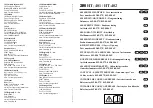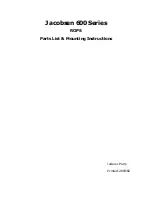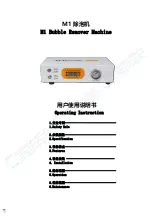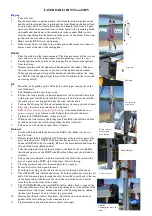
14 – VWR STandaRd Line PiPeTTORS
instruction Manual – 15
Aspirating High-density Liquids
When pipetting liquids of higher viscosity or lower sur-
face tension than water (e.g., sera or organic solvents),
a film of liquid may be formed on the inside of the
pipet tip which may produce erroneous results. as the
film remains relatively constant in successive pipetting
operations with the same tip, this error can be elimi-
nated by pre-rinsing the tip and allowing a film to form
before transferring the first sample. This is achieved by
aspirating a sample and dispensing it back into the
same vessel. allowing a film to form prior to sampling
ensures optimal accuracy and repeatability.
This pre-rinsing operation should be repeated when
the volume to be aspirated is changed or when a new
pipet tip is used.
NOTE:
normally the degree of error resulting from vis-
cous liquids is negligible if pipetting is performed slowly
and carefully, however, this can be minimized further by
holding the pipet tip in position for at least 2 seconds
after aspiration to allow the liquid time to react to the
change in pressure before it is dispensed.
if the above method does not result in accurate values,
recalibrate the pipettor in accordance with Section 9.
it is recommended to record recalibration and correc-
tion values, in order to facilitate reverse calibration to
a standard liquid.
Filters
The 5,000 and 10,000 μL pipettors include a replaceable
filter (L), fitted at the bottom of the shaft which prevents
aspirated liquid from entering the shaft and contami-
nating the inner surface and plunger. Use of the filter is
particularly important when aspirating and dispensing
large volumes of liquid. The filter should be replaced if it
becomes wet.
9. Checking Pipetting Accuracy Parameters
and Pipettor Recalibration
The pipettors have been factory-calibrated using
gravimetric methods with manufacturer pipet tips and
distilled water, in accordance with iSO 8655 guidelines
for the maximum (nominal) liquid volume drawn by the
pipettor and for 10% of the maximum or minimum liquid
volume according to the values given (Section 5).
The pipettors are designed to enable recalibration and
adaptation to different pipetting techniques and liquid
properties (e.g., temperature, density, and viscosity).
Periodic checks of the operation of the pipettor are
recommended at least once per year. Frequency of
checks should be increased depending on workload,
sterilization or autoclave processes, and frequency of
replacement of component parts.
if during pipettor operation the accuracy error (the
difference between the real aspirated volume and the
preset volume) exceeds the permissible value given
in the table in Section 5, pipettor recalibration should be
carried out.
Recalibration of the pipettor involves setting the counter
to the value of the liquid volume obtained by weighing.
Recalibration of the pipettor is valid only for one liquid
volume drawn by the pipettor.
The recommended volume for recalibration is 10%
of the maximum (nominal) value or minimum volume
depending on which of these values is greater. See table
on page 16 for more details.
Parameters for Checking the Pipetting Accuracy
The pipetting accuracy is influenced by factors such as:
tips used, characteristics of the pipetted liquid (density,
viscosity), and operating conditions (ambient tempera-
ture, pressure).
To determine the accuracy error of the pipettor, the fol-
lowing conditions should be met:
•
ambient temperature and temperature of the pipet-
tor, pipet tips, and liquid should be within the range
of 20°C to 25°C and stabilized during weighing within
±0.5°C.
•
Measurements should be conducted using distilled
water.
•
Balance sensitivity should be suitable for the volume
“V” to be measured.
Volume Checked (V, μL)
Balance Sensitivity (mg)
0.1≤V≤10
0.001
10≤V≤100
0.01
100≤V≤1,000
0.1
V>1,000
0.1
•
When calculating the liquid volume aspirated by
the pipettor, the conversion factor (Z) [μL/mg] for dis-
tilled water or a liquid with comparable density should
be taken into account. Sample values of conversion
factors are given in the following table.































